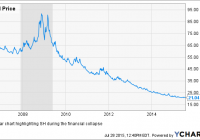Using ETFs To Short The Market
Summary The structure and pricing of inverse and leveraged ETPs is complicated. The principal investments of this fund are money market instruments and derivatives. Daily re-balancing can be a concern. Reading through recent Seeking Alpha articles regarding the broader market, lengthy and often heated discussions tend to develop on the direction of the market. That being said, it seems as if opinions on the eventual breakthrough of the current sideways trading range are about half and half, with maybe slightly more bulls. I also recently read comments on an article about leveraged and inverse exchange-traded products, where many readers did not seem to have a clear understanding of how (particularly) inverse ETPs are priced. In light of these two observations, I thought it pertinent to analyze how an inverse ETF is structured, for the benefit of investors who are considering investing in one in order to profit from potential downside movement. Due to the referenced uncertainty and volatility present in the overall market, I decided to use the ProShares Short S&P 500 ETF (NYSEARCA: SH ) as the subject matter for my analysis. SH is an inverse ETF that attempts to return -1x the return of the S&P 500 on a daily basis. How does it achieve inverse returns? SH achieves returns that are inversely correlated to the S&P 500 by investing in assets and derivatives that perform (or historically perform) well when the market is not performing well. There are four main investments used by ProShares in its inverse index ETFs, and these are: Swaps (derivative market) Futures (derivative market) U.S. Treasury Bills (money market) Repurchase Agreements (money market) Derivatives : The sale of swaps will benefit in a falling market, because the buyer of the swaps is required to pay the seller the amount that the underlying has fallen in price. Inverse exposure through futures is likely most often achieved by short-selling index futures. Money Market Instruments : The use of short-term Treasuries and other money market instruments relates to the fact that short-term debt historically performs inversely to the market. This is due to there being a “flight to safety” when the equity markets are falling. Daily Re-balancing: For periods longer than a single day, the Fund will lose money when the level of the Index is flat, and it is possible that the Fund will lose money even if the level of the Index falls. – SH Prospectus The effect of daily rebalancing is one of the primary misunderstandings regarding inverse or leveraged ETFs that I see on Seeking Alpha. People discuss how they will “invest” in a leveraged ETF and hold it for several weeks, months, or even years in some instances. It is important to recognize that this is not the intended purpose of this type of ETF. These are intended to be traded for short time periods. In order to maintain the proper leverage ratio, inverse returns, and index exposure, SH is rebalanced each day. What this means for an investor is simple to illustrate: Suppose that at the end of the trading day on Monday, you invest $1,000 in a -1x inverse ETF @ $100 per share. The ETF tracks an underlying index with a value of $5,000. At market close on Tuesday, the index has decreased 10% to $4,500. In turn, the ETF has risen 10% to $110. By the close on Wednesday, the index has recovered to the original $5,000 – a roughly 11.11% gain. In turn, the ETF now loses 11.11%, which brings the value of your position to $97.78. Even though the index is exactly the same value as it was when you initiated the position, your position has lost money. This effect is also known as beta slippage. Note: This could theoretically work to your advantage, should the opposite situation occur. Conclusion: Simply by looking at a chart of SH, you will see that if you had held it for the duration of the 2008 collapse, you would have indeed profited: ND data by YCharts However, the return ratio was not accurate, with SH gaining approximately 26.07% from 1st January, 2007 to the first peak and SPX losing approximately 43.25% in the same time frame. In short, an inverse ETF like SH can be a great way to hedge short-term volatility or for intra-day trading, but if an investor is looking to actually short an asset (in this case, the S&P 500) for a long-term position, then it is not the most effective way to do so. Hopefully, with a clearer understanding of how this ETF is structured, prospective investors can make better use of it as a tool for his or her portfolio. Disclosure: I/we have no positions in any stocks mentioned, and no plans to initiate any positions within the next 72 hours. (More…) I wrote this article myself, and it expresses my own opinions. I am not receiving compensation for it (other than from Seeking Alpha). I have no business relationship with any company whose stock is mentioned in this article. Additional disclosure: This article is not intended to offer a recommendation to buy or sell any particular asset, and does not reflect the author’s opinions on the direction of the market. It is simply intended to provide an overview of how a complicated but useful financial instrument works.
